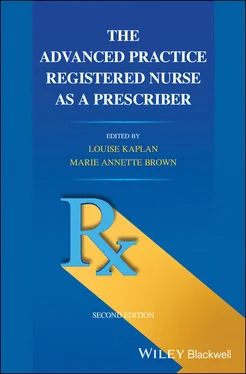Prescriptive authority is the legal ability to prescribe drugs and devices, a practice regulated by the states. One aspect of prescriptive authority, controlled substances (CSs), is specifically regulated by the federal government through the Drug Enforcement Administration (DEA) which enforces the Controlled Substances Act of 1970 (Title 21 – Food and Drugs, 1993). Some states have additional regulations and requirements related to prescribing CSs.
Obtaining prescriptive authority for APRNs has presented significant challenges nationwide. Even when prescriptive authority is supported in new legislation, significant roadblocks to implementation often occur, particularly those placed by physicians. In 1971, for example, Idaho became the first state to pass legislation that recognized the NP role and granted prescriptive authority. Although the first Idaho NP entered practice in 1972, opposition from the Board of Medicine resulted in more than one‐dozen drafts of the prescriptive authority rules. The rules were not adopted until 1977, making Idaho the first state to implement prescriptive authority for NPs (personal communication, S. Evans, December 28, 2009). Nearly 30 years later, in 2006, Georgia became the last state to pass a law granting APRNs authority to “order” medications, a variant of prescribing (Phillips, 2007). An example of a current barrier exists in Colorado. After program completion, an APRN must first qualify for provisional prescriptive authority (RXN‐P). Within three years of receiving RXN‐P status, the APRN must complete a 1000 hour mentorship with a physician or APRN with full prescriptive authority (RXN) and develop an articulated plan for safe prescribing to receive full prescriptive authority (Code of Colorado Regulation, 2017).
ADAPTING TO THE APRN’S ROLE AS PRESCRIBER
Transition to the prescribing role
One of the greatest responsibilities for an APRN is that of prescription medication management. Prescribing is not typically a part of the registered nurse (RN) role in most countries including the US, and often requires a major paradigm shift to transition from administering drugs to selecting and prescribing medications. Consequently, the individual APRN’s transition to the prescriber role involves a union between knowledge of pharmacotherapeutics and socialization to the role. APRNs begin gaining knowledge and competencies throughout their graduate education and continue this process through practice. Role socialization to become a prescriber is initiated during APRN education and likewise is part of continuing professional development.
Transition to the prescriber role is part of the larger role transition that the APRN experiences first as a student, then as a novice practitioner, and when scope of practice changes. Schumacher and Meleis (1994) identified five factors that influence role transition. These continue to be relevant for APRNs in today’s practice arena. They are:
1 Personal meaning of the transition
2 Degree of planning for the transition
3 Environmental barriers and supports
4 Level of knowledge and skill
5 Expectations.
Identification of these factors may allow the APRN to prepare ways for a smooth transition, although there are other dimensions of transition that also need to be considered.
Students in APRN programs typically experience a role transition process that involves role confusion and role strain, including tension, frustration, and anxiety (Brykcznski, 2019). Role acquisition extends to the practicing APRN. The first year of practice is an especially challenging one. A study by Brown and Olshansky (1998) identified four stages in the transition to the primary care NP role. These are laying the foundation, launching, meeting the challenge, and broadening the perspective. Table 2.1describes these stages. The study findings revealed the importance of skillful mentors who serve as a compass to guide the NP and serve as a source of information and support. Access to a mentor can be especially important in respect to adoption of the role of a prescriber, which brings a special set of challenges.
Table 2.1 Nurse practitioners’ experience during the first year of primary care practice
Source : From Brown and Olshansky (1998), reprinted with permission from Wolters Kluwer Health.
| Stage 1: Laying the Foundation |
| Recuperating from school |
| Negotiating the bureaucracy |
| Looking for a job |
| Worrying |
| Stage 2: Launching |
| Feeling real |
| Getting through the day |
| Battling time |
| Confronting anxiety |
| Stage 3: Meeting the challenge |
| Increasing competence |
| Gaining confidence |
| Acknowledging system problems |
| Stage 4: Broadening the perspective |
| Developing system savvy |
| Affirming oneself |
| Upping the ante |
Grappling with general questions about prescribing contributes to professional development and strengthens prescribing expertise during an APRN’s career.
What is the APRN’s role in a particular healthcare setting?
What is the APRN’s relationship to a collaborating or supervising physician when this relationship is required by state law?
What if I disagree with a physician about the choice of the most appropriate medication?
How does one adapt when relocating to a state with a different scope of practice?
General questions are often followed by more specific patient‐centered questions. For example:
Am I making the right medication choice?
Is medication the most appropriate treatment option or should non‐pharmacologic approaches be used at this point in the treatment trajectory?
What type of antibiotic should be prescribed to treat a methicillin‐resistant Staphylococcus aureus infection?
When should a person with type 2 diabetes consider beginning insulin therapy?
What is the appropriate medication to manage acute, subacute, or chronic pain?
When faced with the reality of determining specific practice decisions, particularly those about prescribing, the novice APRN may experience a sense of uncertainty. Novice APRNs enter advanced practice step‐by‐step, decision‐by‐decision. Experience is a remarkable teacher, and, gradually, APRNs develop their professional practice and role identity which includes competence in prescribing. APRNs need time to transition into their new role. It is key, however, to emphasize that a novice APRN receiving the wisdom of a trusted colleague is different than the “requirement” for physician supervision. All novice prescribers, including physicians, benefit from this type of support.
Another aspect of adopting the APRN role is to contend with constraints imposed on all prescribers by health plans and healthcare delivery systems. For example, insurers promote the use of generic medications by requiring higher co‐payments or refusing to pay for some brand‐name drugs. Healthcare systems such as the Veterans Health Administration (VA) and health maintenance organizations such as Kaiser Permanente increasingly use formularies. These limit the medications that are paid for by the health plan, which promotes the use of generic drugs. For the most part, use of generic drugs is an important approach to address skyrocketing US healthcare costs, especially if they produce the same outcomes as branded medication. There are situations, however, in which the patient responds differently to generic vs. branded drugs. The APRN can be limited to only the generic, which compromises patient care. When a branded or non‐covered medication is necessary, a particularly time‐consuming, infuriating, and complex challenge is the prior authorization process. Providers must obtain permission from the health plan to make an exception to the policy (Jones et al., 2019).
Читать дальше












